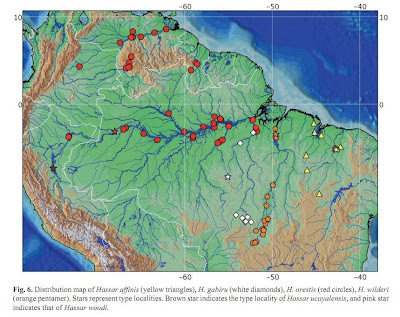
Pristimantis aureoventris
Abstract
A new strabomantid frog of the genus Pristimantis Jiménez de la Espada, 1871 is described from the Eastern Pantepui Region, Guiana Shield, northern South America. The new species, Pristimantis aureoventris sp. nov., is known so far from two neighbouring tepuis, namely Wei Assipu Tepui (type locality) at the border between Guyana and Brazil and Mount Roraima in Guyana, and occurs between 2210–2305 m elevation. The new taxon is distinguished from all known congeners by the following combination of characters: Finger I < II; tympanum distinct; basal webbing between Toes IVV; broad lateral fringes on fingers and toes; ventral skin areolate; vocal slits absent in male; two non-spinous whitish nuptial pads and vocal sac present in male; high degree of pattern polymorphism; throat, chest, and belly golden yellow, usually with reddish brown to dark brown mottling; internal organs little or not visible through the ventral skin in life. The call of the new species consists of bouts of a single amplitude-modulated (decreasing to the end) note repeated at a rate of ca. 18 notes/min with a dominant frequency ranging from 2180 to 2430 Hz.
Key words: Amphibia, Brazil, Guiana Shield, Guyana, Mount Roraima, systematics, taxonomy, Venezuela, Wei Assipu Tepu


Kok et al. (2011) A new highland species of Pristimantis Jiménez de la Espada, 1871 (Anura: Strabomantidae) from the Pantepui region, northern South America. Zootaxa 2934: 1–19. http://www.mapress.com/zootaxa/2011/f/z02826p068f.pdf





















